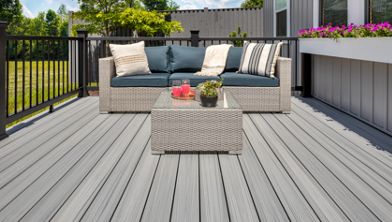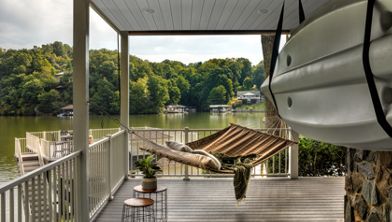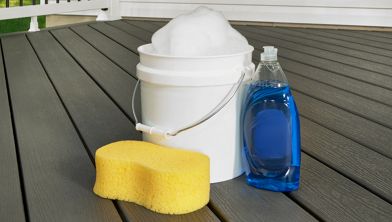What is the Best Low-Maintenance Decking?
Discover the average maintenance for different types of decking materials to help determine the right material for your next deck project.
The right decking material shouldn't just be aesthetically pleasing. It should also allow you to spend more time enjoying your backyard space - instead of caring for it endlessly. While there’s no such thing as a maintenance-free deck, some decking materials require less maintenance than others.
What Decks Do Not Require Maintenance?
No singular type of decking material is maintenance-free. If you own a deck, you’ll need to commit to some level of upkeep to keep it looking beautiful and to ensure the integrity of the structure over time. While “no-maintenance decks” don’t exist, there are types of decking material that require considerably less maintenance than others.
Composite decking is a low-maintenance option that offers the look of wood without the high degree of upkeep. Wooden decking requires annual sanding, sealing, and staining to prevent rot due to constant exposure to the elements. By contrast, composite decking can be cleaned periodically with simple soap and water. Composite decking options like Trex, for instance, are made to resist fading, staining, and damage caused by the elements and won't become food for insects.
Why Does Low Maintenance Matter?
Low-maintenance decking gives you more time to actually enjoy your deck instead of taking care of it. While low-maintenance options like composite decking only require an occasional cleaning with just soap and water, wooden decking is far more labor-intensive. You’ll need to set aside time each year to properly stain, seal, or paint wooden decking to protect it from mold, moisture, and UV rays that can compromise its structural integrity.
Maintaining a wood deck isn’t just a drain on your time and money. It can also be a drain on the environment, contributing to deforestation and requiring the use of chemicals to stain and protect your decking.
Although a well-maintained natural wood deck can last for up to 20 years, you may have to replace wooden deck boards due to deterioration over time. This can lead to an almost “patchwork” effect, with new boards looking less uniform across your deck and detracting from its beauty.
On the flip side, composite decking offers built-in protection due to a weather-resistant outer shell made from reclaimed plastic film and post-consumer sawdust. This mixture of organic and man-made materials makes composite decking stand up to the elements, without fading or warping. As a result, it requires minimal maintenance to keep it looking its best.
Fade-resistant composite decking ensures consistency of color and structural integrity over time. Although the initial cost of composite decking may be slightly higher than wood, it offers long-term savings, reducing time and money spent on maintenance, repairs, and replacement through the years. Beyond time- and cost-savings, composite decking is backed by limited residential warranties, ranging between 25 and 50 years, depending on the line of decking you choose.
As a bonus, many composite decking brands use recycled materials in their composition, making them an eco-friendly alternative. In fact, most Trex composite decking lines are made from 95% recycled and reclaimed material, making Trex one of the largest plastic film recyclers in North America. Each year, the company repurposes more than 1 billion pounds of these materials and upcycled more than 5 billion pounds of discarded polyethylene film over the past three decades.
What Factors Can Increase the Amount of Maintenance a Deck Needs?
Seemingly simple factors – like where you live and the type of materials you use – can impact the amount of upkeep required to keep your deck looking and performing its best.
Material
The type of material used to build your deck plays a role in how much maintenance is required. Wood decking requires annual staining and weather-proofing to minimize rot and warping. Older wood decks require frequent inspection to repair or replace warped or moldy boards that can pose a hazard. Although hardwoods – such as cedar or redwood – may be more resistant to decay and degradation over time, like all-natural woods, they still require considerably more upkeep than composite, which is engineered to resist the elements.
Weather and Location
The area where you live and its geographic features – such as weather and proximity to corrosive saltwater bodies – can also impact your decking. If you live in a part of the country with heavy rain or snow, constant exposure to moisture can more rapidly age your wood, requiring a more diligent maintenance schedule. High humidity can also cause natural wood to expand and contract, warping your decking over time. By contrast, composite decking is one of the best deck material options, regardless of where you live and any geographic conditions you face. Composite decking can be an outstanding choice for those living in damp, humid regions, as composite boards tend to resist mold, rot, splinters, and warping. Also, in the last several years, new decking lines have offered heat-resistant properties to keep boards cooler underfoot. For these reasons, it can also be a good choice for a deck incorporating a swimming pool, hot tub, or dock.
Heavy Foot Traffic
Over time, wooden decking will experience wear and tear. Heavy foot traffic – whether that means frequently entertaining guests or young children playing on your deck – can wear down a natural wood deck over time, making it more prone to splintering. If you have a wooden deck, you’ll need to sand and seal your deck periodically to maintain a smooth, splinter-free surface due to heavy use. Composite decking, however, can be a better choice for decks that have heavy foot traffic. Its durable construction makes it less susceptible to splintering, cracking, or warping.
Poor Construction
Regardless of material, a poorly constructed deck will mean more maintenance over time. Although composite decking can be more forgiving than wood, thanks to its resistance to rot and warping, it’s important to work with a knowledgeable, reputable builder to construct your deck to ensure structural stability.
A poorly constructed wood deck may deteriorate faster due to an inadequate support structure. This can accelerate deterioration since loads may not be balanced, putting more stress on the materials. Overall, a poorly constructed deck may wind up being a money pit, requiring more frequent repairs or an outright replacement.
What is the Lowest Maintenance Decking Material?
While any deck will require a little TLC over time to keep it looking its best, composite decking is arguably one of the lowest maintenance decking materials available today. It combines the best of both worlds – recycled organic materials like sawdust, blended with plastic film – to produce decking that resists fading, staining, warping, and rotting. Beyond sweeping your deck to remove dirt and debris, the most maintenance required to keep your composite deck looking beautiful is a gentle cleaning with soap and water or a quick power wash.
Do Treated Wood Decks Require Maintenance?
Even a treated wood deck will require considerably more maintenance than other options. Although pressure-treated woods are less prone to rot than untreated wood, their porous surface makes them just as susceptible to developing algae or mold over time.
Exotic hardwoods like ipe are recognized for their longevity, but will still require regular cleaning, sanding, and sealing with high-quality products. This can help prolong its life, mitigating some of the constant exposure to the elements and damaging UV rays.
A maintenance regimen for a wood deck made from ipe, for instance, involves seasonal cleanings with a hose or pressure washer. Consider a thorough cleaning to remove leftover debris from falling autumn leaves and windblown winter items. You’ll also want to clean your wooden deck again in spring to remove pollen grains – which can scratch or stain your wood’s surface if left to linger.
Scratches can also compromise the beauty of your wooden deck and can appear with regular use. Lightly sand any scratches that appear on your deck. If left untended, these areas can allow moisture to creep into any cracks that have breached any protective sealant coating. This can lead to the development of mold. Be sure to sand, refinish, and re-seal any scratches as soon as you spot them.
As ipe wood ages, it turns from a beautiful reddish-hue to a more subdued gray tone. This is due to the natural oils in an ipe deck oxidizing from sun exposure. If a weathered look speaks to your aesthetic, or your preferences change over time, this can be a bonus. However, if you loved the original look of your ipe deck, it can take considerable work to restore its red-brown coloring. You’ll need to sand the surface of your deck to remove the oxidized gray top layer and reveal a new layer closer to its original hue beneath the surface. Afterward, be sure to seal your deck and add a layer of UV protection.
Most importantly, you’ll also want to stain and seal your wooden deck each year. Frequent exposure to the sun and UV rays can wear down the previous year’s coat. Lightly sanding your ipe deck will help a high-quality sealant absorb better and help prevent warping and buckling of your boards.
When comparing Trex vs wood decking, composite decking like Trex requires a lot less upkeep. While you’ll want to sweep your deck frequently to keep it neat and clean, there is no need to stain or reseal your deck year after year. Just a gentle wash with soap and water each year can help your composite deck look as beautiful as it did the day it was built!
Choose Trex for Low-Maintenance Decking Material
Like any beautiful thing, owning a deck requires regular maintenance to ensure it remains in pristine condition while you enjoy it for years to come. However, some materials require a lot more maintenance than others. Trex composite decking is a low-maintenance deck material that offers the rich look of natural wood – but with the added benefit of fade-, scratch-, and rot resistance. With a variety of colors and options to choose from, Trex decking gives you a beautiful space to relax and more time to enjoy it. Want to learn more about what makes Trex decking different? Compare how the various Trex decking lines compare to pressure-treated wood.
How Much Does It Cost to Build a Low-Maintenance Deck?
While there are up-front costs to consider when building a deck, there is also the cost of maintenance over time depending on the materials you choose. Although wood decking materials can range as low as $2.50 per square foot for pressure-treated pine all the way up to $25 per square foot for exotic woods like ipe and mahogany, you’ll also need to factor in the time- and monetary cost of investing in quality materials to sand, stain, and seal your deck year after year.
The cost of composite decking like Trex can range between $4.60 and $13.60 per square foot but requires far less intensive upkeep. Since you don’t have to sand, stain, or treat composite decking, it’s one less line item on your budget each year.
How Long Does Low-Maintenance Decking Last?
Low-maintenance decking like Trex can last for decades, requiring minimal upkeep throughout the lifetime of your deck. Trex decking is backed by a limited residential warranty, ranging between 25 and 50 years, depending on which Trex products you choose.
Find the Best Trex Low Maintenance Option to Fit Your Space
If you love the look of natural wood, but don’t love the rigorous upkeep associated with it, Trex offers a variety of decking and railing options that are as breathtaking as they are low-maintenance.
Compare the features, color options, and cost between the various decking lines to find the right fit for your outdoor space.
This content was partially or fully generated by AI and has been reviewed by our team to ensure accuracy and relevance.






































